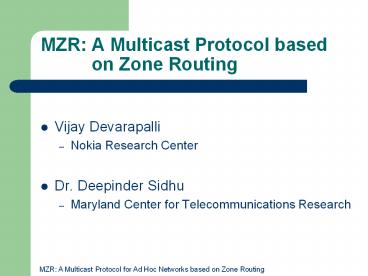MZR: A Multicast Protocol based on Zone Routing PowerPoint PPT Presentation
Title: MZR: A Multicast Protocol based on Zone Routing
1
MZR A Multicast Protocol based on Zone
Routing
- Vijay Devarapalli
- Nokia Research Center
- Dr. Deepinder Sidhu
- Maryland Center for Telecommunications Research
2
Presentation Overview
- Introduction to MZR
- Proactive and Reactive Routing Protocols
- Zone Routing Protocol
- Details of how MZR functions
- Performance Analysis
- Conclusions
3
Introduction to MZR
- What is MZR?
- Its a source initiated on-demand multicast
routing protocol - Builds a multicast delivery tree rooted at the
source based on the zone routing protocol - Does not depend on any underlying unicast
protocol for global routing substructure - Why Multicast?
- Ad hoc network ? collaborative computing
4
Proactive versus Reactive
- Proactive Routing Protocols
- Exchange routing information periodically to
maintain an up-to-date routing table - React to each network topology change
- Problems
- High percentage of bandwidth used for routing
information - Only a small fraction of the control traffic may
be used
5
Proactive versus Reactive
- Reactive Routing Protocols
- An initial route discovery process
- Minimal reaction to topology change
- Problems
- Route information may not be available at the
time of route request - The route discovery process is typically
implemented as a global flood-search procedure - Explosion of control traffic
6
Zone Routing Protocol
- Hybrid (proactive and reactive) routing protocol
- Proactive procedure limited to nodes local
neighborhood (zone) - Global search is carried out by querying selected
(border) nodes
7
Details of MZR
- Zone Construction and Maintenance
- Each node constructs a zone around itself using a
pre-configured radius - Zone Routing Table built using ADVERTISEMENT
packet - Periodic advertisements keep routing table
up-to-date - Interior and Border nodes can be identified using
the Zone Routing Table
8
Details of MZR
- Multicast Tree Creation
- For each multicast session a tree rooted at the
source is created. - The tree is identified by ltsource, groupgt pair
- Multicast route entry consists of
- Multicast session id
- ltsource, groupgt pair
- IP address of upstream node
- A list of the downstream nodes
9
Details of MZR
- Multicast Tree Creation (continued)
- Tree Creation is a two step process
- Step 1 Extend tree inside zone
- Source sends a TREE-CREATE to each zone node
- As the TREE-CREATE packet is propagated reverse
routes are created at each intermediate node - An interested node replies with a TREE-CREATE-ACK
- The TREE-CREATE-ACK is sent back through the
reverse route - As it propagates, the multicast route entry is
completed and activated
10
Details of MZR
- Multicast Tree Creation (continued)
11
Details of MZR
- Step 2 Extend tree to the entire network
- Source sends a TREE-PROPAGATE message to border
nodes - On receiving the TREE-PROPAGATE the border node
does the following things - Sends a TREE-CREATE packet to all its zone nodes
and the procedure described in Step 1 is followed - Once it is done with the zone nodes it sends a
TREE-PROPAGATE message to its border nodes
12
Details of MZR
13
Details of MZR
- Routing Mechanism
- Source starts transmitting once the multicast
delivery tree is created - Internal nodes of the tree replicate received
data packets and send a copy to each node on the
downstream list - Transmission to a downstream node is stopped once
that node migrates
14
Details of MZR
- Maintaining up-to-date routing information
- Timer for each route entry
- Stale route entries removed on time-out
- To keep routes active within multicast session
source sends TREE-REFRESH packet
15
Details of MZR
- Reaction to Link Breaks
- Downstream nodes responsible for detecting link
breaks - On detecting a link break the downstream node
initiates a global search using the zone routing
mechanism - Similar method to Tree creation
- JOIN JOIN-ACK
- JOIN-PROPAGATE
16
Details of MZR
- Leaving a multicast group
- When tree member wants to leave the group it
sends an TREE-PRUNE message to its upstream node - The upstream node removes the node from its
downstream list - If the downstream list of an intermediate node
becomes empty then it sends a TREE-PRUNE to its
upstream node
17
Performance Analysis
- Simulation Model
- 50 mobile nodes moving according to the random
waypoint model on a 500m x 500m 2D grid - Running time of simulation was 300 seconds
- Transmission range is set to 100 meters
- Link capacity assumed to be 2 Mbps
18
Performance Analysis
- Packet Delivery Ratio (PDR) and Node Mobility
- PDR D / N
- D ? number of data packets actually delivered to
multicast group members - N ? total number of packets that were supposed to
be delivered
19
Performance Analysis
- Packet Delivery Ratio (PDR) and Node Mobility
20
Performance Analysis
- Routing Overhead and Node Mobility
- Ratio of control packets sent versus all packets
sent
21
Performance Analysis
- Routing Overhead and Multicast Group Size
22
Performance Analysis
- Packet Delivery Ratio and Multicast Group Size
23
Conclusions
- New source initiated, on demand multicast routing
protocol for ad hoc networks - Builds a multicast delivery tree and does not
depend on any underlying unicast mechanism - Every multicast receiver in the ad hoc network
joins in finite time - Scales well for different group sizes and
different mobility speeds

